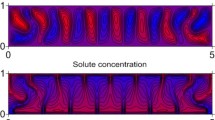Abstract
The critical time of transition to the convective mode of the unsteady-state evaporation of a horizontal layer of a binary solution into a stagnant gas is theoretically and experimentally determined. It is shown that the slow diffusion mode of evaporation can be destabilized and replaced by the convective mode if the molecular weight of one of the liquid components is higher than the molecular weight of the gas and the molecular weight of the other liquid components is lower than the molecular weight of the gas. The neutral stability curve of the diffusion mode is determined using the Navier-Stokes equation in the Boussinesq approximation, the continuity equation, and the convective diffusion equations of the evaporating components. The transition between the modes is faster than the molecular diffusion; therefore, the depth of penetration of the vapor of the light component into the gas in the diffusion mode can be taken as the linear scale of the phenomenon considered. By the Galerkin method, the neutral stability curve of the diffusion mode of evaporation is determined and the critical time of bifurcation of the mode is found as a function of the composition of an aqueous butanol solution. The theoretical and experimental data are in good agreement.
Similar content being viewed by others
REFERENCES
Landau, L.D., Akhiezer, A.I., and Lifshitz, E.M., Kurs obshchei fiziki (Course in General Physics), Moscow: Nauka, 1969.
Landau, L.D. and Kitaigorodskii, A.I., Molekuly (Molecules), Moscow: Nauka, 1978.
Berman, L.D., Evaporation, in Khimicheskaya entsiklopediya (Chemical Encyclopedia), Moscow: Sovetskaya Entsiklopedia, 1990.
Bird, R.B., Stewart, W.E., and Lightfoot, E.N., Transport Phenomena, New York: Wiley International, 1960. Translated under the title Yavleniya perenosa, Moscow: Khimiya, 1974.
Dil'man, V.V., Lotkhov, V.A., Kulov, N.N., and Naidenov, V.I., Evaporation Dynamics, Teor. Osn. Khim. Tekhnol., 2000, vol. 34, no.3, pp. 227–236 [Theor. Found. Chem. Eng. (Engl. Transl.), vol. 34, no. 3, pp. 201–210].
Lotkhov, V.A., Dil'man, V.V., Vasilevskii, D.I., and Lipatov, D.A., Dynamics of Unsteady-State Evaporation of Binary Mixtures in Closed Systems, Teor. Osn. Khim. Tekhnol., 2003, vol. 37, no.2, pp. 147–152 [Theor. Found. Chem. Eng. (Engl. Transl.), vol. 37, no. 2, pp. 131–136].
Dil'man, V.V., Lotkhov, V.A., Kaminskii, V.A., and Lipatov, D.A., Evaporation of Binary Solutions with the Rayleigh Instability in the Gas Phase, Zh. Fiz. Khim., 2004, vol. 78, no.12, pp. 2284–2288 [Russ. J. Phys. Chem. (Engl. Transl.), vol. 78, no. 12, pp. 2023–2027].
Carslaw, H.S. and Jaeger, J.C., Conduction of Heat in Solids, Oxford: Clarendon, 1947. Translated under the title Teploprovodnost' tverdykh tel, Moscow: Nauka, 1964.
Dil'man, V.V. and Polyanin, A.D., Metody model'nykh uravnenii i analogii (Methods of Model Equations and Analogies), Moscow: Khimiya, 1988.
Author information
Authors and Affiliations
Additional information
__________
Translated from Teoreticheskie Osnovy Khimicheskoi Tekhnologii, Vol. 39, No. 6, 2005, pp. 600–606.
Original Russian Text Copyright © 2005 by Dil'man, Lipatov, Lotkhov, Kaminskii.
Rights and permissions
About this article
Cite this article
Dil'man, V.V., Lipatov, D.A., Lotkhov, V.A. et al. Instability in Unsteady-State Evaporation of Binary Solutions into an Inert Gas. Theor Found Chem Eng 39, 566–572 (2005). https://doi.org/10.1007/s11236-005-0118-0
Received:
Issue Date:
DOI: https://doi.org/10.1007/s11236-005-0118-0




